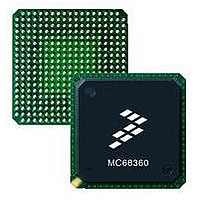MC68EN360CAI25L Freescale Semiconductor, MC68EN360CAI25L Datasheet - Page 923

MC68EN360CAI25L
Manufacturer Part Number
MC68EN360CAI25L
Description
IC MPU QUICC 25MHZ 240-FQFP
Manufacturer
Freescale Semiconductor
Series
MC68000r
Datasheets
1.MC68EN302AG20BT.pdf
(8 pages)
2.MC68EN360VR25L.pdf
(14 pages)
3.MC68EN360VR25L.pdf
(2 pages)
4.MC68EN360CAI25L.pdf
(962 pages)
Specifications of MC68EN360CAI25L
Processor Type
M683xx 32-Bit
Speed
25MHz
Voltage
5V
Mounting Type
Surface Mount
Package / Case
240-FQFP
Core Size
32 Bit
Cpu Speed
25MHz
Embedded Interface Type
SCP, TDM
Digital Ic Case Style
FQFP
No. Of Pins
240
Supply Voltage Range
4.75V To 5.25V
Rohs Compliant
Yes
Family Name
M68xxx
Device Core
ColdFire
Device Core Size
32b
Frequency (max)
25MHz
Instruction Set Architecture
RISC
Supply Voltage 1 (typ)
5V
Operating Supply Voltage (max)
5.25V
Operating Supply Voltage (min)
4.75V
Operating Temp Range
-40C to 85C
Operating Temperature Classification
Industrial
Mounting
Surface Mount
Pin Count
240
Package Type
FQFP
Lead Free Status / RoHS Status
Lead free / RoHS Compliant
Features
-
Lead Free Status / Rohs Status
Compliant
Available stocks
Company
Part Number
Manufacturer
Quantity
Price
Company:
Part Number:
MC68EN360CAI25L
Manufacturer:
APLHA
Quantity:
12 000
Company:
Part Number:
MC68EN360CAI25L
Manufacturer:
Freescale Semiconductor
Quantity:
10 000
Part Number:
MC68EN360CAI25L
Manufacturer:
FREESCALE
Quantity:
20 000
- MC68EN302AG20BT PDF datasheet
- MC68EN360VR25L PDF datasheet #2
- MC68EN360VR25L PDF datasheet #3
- MC68EN360CAI25L PDF datasheet #4
- Current page: 923 of 962
- Download datasheet (4Mb)
Freescale Semiconductor, Inc.
APPENDIX C
RISC MICROCODE FROM RAM
The RISC processor in the QUICC has an option to execute microcode from the first 512 or
1024 bytes of the internal dual-port RAM. Motorola uses this feature to enhance existing pro-
tocols or implement additional protocols. Customers can purchase one or more of these
RAM microcodes in an object-code format and download it to the QUICC dual-port RAM dur-
ing system initialization.
The RAM microcode is provided by Motorola as a set of S-records that can be downloaded
directly to an application development system or stored in a system EPROM. After system
reset, the binary of the microcode should be copied to the QUICC dual-port RAM. The
QUICC registers, including the RISC controller configuration register (RCCR), should be ini-
tialized as specified in the microcode RAM documentation. Before the RISC is used in the
system, the user should issue a reset command to the communications processor command
register (CR). The microcode RAM functions are available in addition to all protocols avail-
able in the standard QUICC microcode ROM.
The following microcode RAM protocols are completed, in progress, or under consideration
by Motorola. Please contact the local Motorola semiconductor sales office for further infor-
mation on these packages.
C.1 SIGNALING SYSTEM #7 CONTROLLER
Signalling System #7 (SS7) is a management protocol used in public switching networks.
The physical, data link, and network layer functions of the SS7 protocol are called the Mes-
sage Transfer Part (MTP).
The data link layer portion of the MTP (layer 2) is based upon HDLC frame formats. How-
ever, SS7 at layer 2 also includes some unique functions that are difficult to implement using
an unaltered HDLC controller. These functions include: counting the number of octets by
which a frame is too long; sending fill in signal units (FISUs) and link status signal units
(LSSUs) continuously; maintaining the SU Error Monitor; and filtering duplicate back-to-
back frames.
FISUs are 5 byte frames (three bytes plus 2 CRC bytes) that are sent continuously back-to-
back when no other data needs to be transmitted. LSSUs are also sent back-to-back during
the initial alignment of the protocol. LSSUs are 6 or 7 bytes long. SS7 also differs from
other HDLC-based protocols in that the closing flag of one frame can be the opening flag of
the next frame. Since these characteristics can make SS7 implementations very demand-
ing, the SS7 controller on the QUICC provides additional help in these areas.
MC68360 USER’S MANUAL
For More Information On This Product,
Go to: www.freescale.com
Related parts for MC68EN360CAI25L
Image
Part Number
Description
Manufacturer
Datasheet
Request
R
Part Number:
Description:
Manufacturer:
Freescale Semiconductor, Inc
Datasheet:
Part Number:
Description:
Manufacturer:
Freescale Semiconductor, Inc
Datasheet:
Part Number:
Description:
Manufacturer:
Freescale Semiconductor, Inc
Datasheet:
Part Number:
Description:
Manufacturer:
Freescale Semiconductor, Inc
Datasheet:
Part Number:
Description:
Manufacturer:
Freescale Semiconductor, Inc
Datasheet:
Part Number:
Description:
Manufacturer:
Freescale Semiconductor, Inc
Datasheet:
Part Number:
Description:
Manufacturer:
Freescale Semiconductor, Inc
Datasheet:
Part Number:
Description:
Manufacturer:
Freescale Semiconductor, Inc
Datasheet:
Part Number:
Description:
Manufacturer:
Freescale Semiconductor, Inc
Datasheet:
Part Number:
Description:
Manufacturer:
Freescale Semiconductor, Inc
Datasheet:
Part Number:
Description:
Manufacturer:
Freescale Semiconductor, Inc
Datasheet:
Part Number:
Description:
Manufacturer:
Freescale Semiconductor, Inc
Datasheet:
Part Number:
Description:
Manufacturer:
Freescale Semiconductor, Inc
Datasheet:
Part Number:
Description:
Manufacturer:
Freescale Semiconductor, Inc
Datasheet:
Part Number:
Description:
Manufacturer:
Freescale Semiconductor, Inc
Datasheet:











